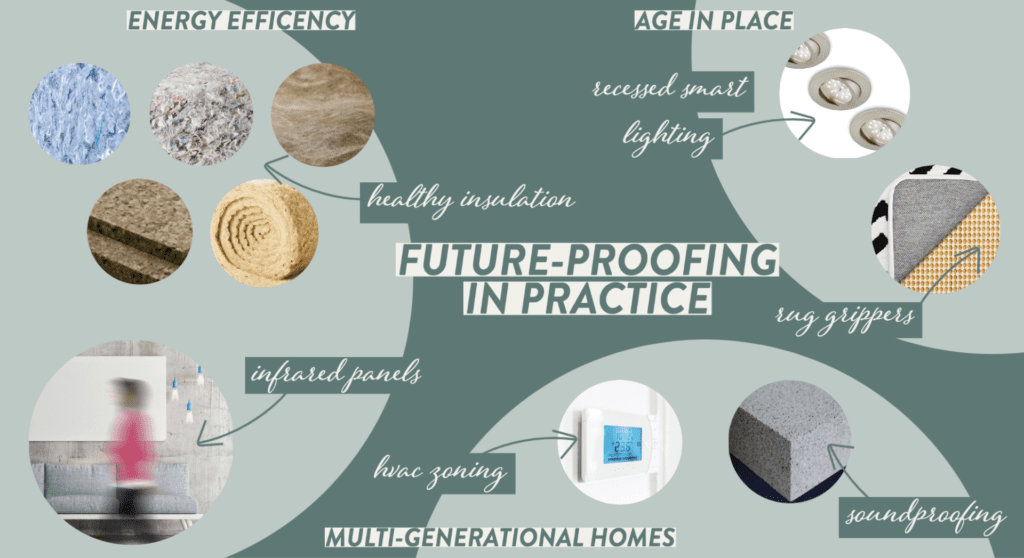
Following on from my last post regarding why you should consider future-proofing when renovating your home. I thought it would be helpful to share some suggestions for future-proofing in practice.
Any way you can improve your home to impact its sustainability and create a healthier environment is an excellent step toward future-proofing. Here are some targeted recommendations depending on your situation, where you will likely see the most bang for your buck regarding health and sustainability.
Energy efficiency
Insulation
Sufficiently insulating your home undoubtedly is one of the best budget spends on a renovation. It will improve your home's energy efficiency, Reduce your carbon footprint, and save you money. Whilst natural, healthy insulation will also improve your home's air quality.
According to a report done by Energy Efficiency For All, some of the healthiest, most cost-efficient, and most straightforward insulation to install include:
- Cork
- Fibreglass
- Cellulose
- Recycled cotton
- Sheep's wool
Infra-red heating panels
Honestly, this was the best investment I made in my property! This underrated product needs more air time.
Unlike convection heaters (such as radiators and storage heaters) that heat the air, infrared panels radiate heat much like the sun. It heats objects in your space, which means the warmth generated can't be lost through draughts, so you won't be wasting energy. Good quality infra-red heating panels have high efficiency with proven savings of as much as 50% compared with other conventional heating systems.
They also have a plethora of other benefits:
- With no moving parts, they are straightforward to maintain
- They heat quickly
- Space efficiency, and if wall space is at a premium, you can, like me, install them on your ceilings or get panels that also serve as a mirror. Great for bathrooms; the best bit is they don't fog up when on!
- They are simple to install - plug and play.
One of the biggest reasons I buy into this technology is its health benefits! Conventional radiators heat the room by moving air around it, which disturbs dust and particles, making it more likely to breathe them in. Bad news if you have asthma or allergies. Infrared heats objects, so there isn't this issue. It also means that because of the very nature of heating objects, not air, your property is less likely to be damp and mouldy! WIN! Check out Redwell infrared heating for more information.
Age in place
Rug Gripper'
It may not be the most enthralling of things to implement in your home renovations. However, it's likely one of the easiest and most preventative methods of ensuring health and wellbeing in your home, especially if you want to age in place.
Falling over is not an inevitable part of getting older. However, a third of people over 65 will fall over at least once a year, which rises to 50% for those in their 80s.
A fall can have far-reaching implications, from shaking confidence to severe impacts on mobility or even, in 10% of cases, result in death within a year. What a scary number! So, whatever we can do to minimise falls, especially in senior generations, is worth special consideration.
Most falls occur at home, and rugs are a significant cause. This is easily remedied with a very cost-effective solution, a rug gripper. They essentially stick a rug to the floor (without harming either). So the corners of the rug won't come up and won't slip on the floor when someone walks on it. Cheap. Simple. Effective! Who says future-proofing the home is expensive?
Lighting
This suggestion is a preventative method in much the same vein as the rug gripper. After all, prevention is better than a cure.
Older generations require light levels three to five times higher than young people due to age-related changes to the eyes and eye diseases. So lighting will become an ever more critical part of your everyday life if you wish to age in place. It will add comfort and enjoyment to your home, and a well-illuminated home is safer.
If you are renovating, a foundational principle of wellness interior design is to maximise natural light in your spaces. It will minimise your reliance on artificial light and the associated energy usage during the day, and its positive implications on health and wellbeing are tangible.
Unfortunately, we can't live by natural light alone, so a well-planned and executed lighting scheme is paramount when future-proofing a home to age in place.
You will want to brighten up the rooms of your home, especially the ones you spend most of your time. Ambient lighting is the general lighting within a space. I recommend recessed lighting as this will minimise shadows from light fittings, and they do an excellent job of spreading light across an entire room. For added convenience, you can now get inexpensive smart recessed bulbs that connect to a voice-activated device. So you wont to need to fumble in the dark to turn the lights on.
Multi-Generational Homes
Soundproofing
Studies have determined that unwanted sound pollution hinders people's health and well-being in several ways. The acoustic comfort of a home can be quantified by its occupants' overall satisfaction level. More occupants mean more sound and different sound comfort levels between generations, making soundproofing a multi-generational home a critical priority.
With this in mind, I recommend adding mineral wool insulation between joists and stud partition walls. Ensure you source the non-toxic brands or use acoustic panels that do not harm the environment or human health, such as Quietstone.
HVAC (Heating, ventilation & air conditioning) Zoning
Temperature can be contentious if you've ever shared space with many people. With so many individual factors at play that include physiological, psychological and context-related reasons, there is no such thing as the 'perfect' temperature for everyone.
When future-proofing your home for multi-generational living, it's essential to consider that different generations will have different perceptions of temperature and comfort levels. If the thermal comfort of a home isn't right, it can have a detrimental impact on the occupant's health, safety, productivity and mental well-being.
To ensure everyone's comfort, you should be able to control individual rooms or areas to meet the different thermal needs of its users. Of course, if you have shared communal spaces, you must accept that you may still have the temperature debate. But at least everyone can escape rooms better suited to their preferences if things get frosty or heated!
In summary, these are only a few suggestions for future-proofing in your home. A sustainable and healthy home requires special consideration of each occupants changing needs, and it's safe to say every home is different.
If you are renovating and would like help to define what future-proofing strategies will best serve your needs now and in the future, get in touch. The spaces I create work better and harder for your changing needs, with a focus on future-proofing to improve your overall quality of life.



No comments.